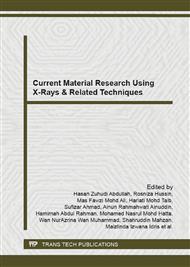[1]
A. Mittal, R. Katahira, M. E. Himmel and D. K. Johnson, Effect of Alkaline or Liquid-ammonia Treatment on Crystalline Cellulose: Changes in Crystalline Structure and Effects on Enzymatic Digestibility, Biotechnology for Biofuels, (2011), 4: 41.
DOI: 10.1186/1754-6834-4-41
Google Scholar
[2]
J. Asik, F. A. Aziz, and R. Idris, XRD and FTIR of Natural Cellulose Isolated from Acacia mangium, belian (Euxideroxilon zwagery) and Sawmill Sawdust, Asian chemistry letter, India: Anita Publication, (2010), (14): 4.
Google Scholar
[3]
G. Gong, A. P. Mathew and K. Oksman, Strong Aqueous Gels of Cellulose Nanofibers and Nanowhisers Isolated from Softwood Flour, TAPPI Journal, (2011), pp.7-14.
DOI: 10.32964/tj10.2.7
Google Scholar
[4]
N. Terinte, R. Ibbett and K. C. Schuster, Overview on Native Cellulose and Microcrystalline Cellulose I Structure by X-Ray Diffraction (WAXD): Comparison Between Measurement Techniques, Lenzinger Berichte 89, (2011), pp.118-131.
Google Scholar
[5]
V. K. Varshney and S. Naithani, Chapter 2: Chemical Functionalization of Cellulose Derived from Nonconventional Sources, ISBN: 978-3-642-17369-1, (2011), pp.43-60.
DOI: 10.1007/978-3-642-17370-7_2
Google Scholar
[6]
G. Müller, C. Schöpper, H. Vos, A. Kharazipour and A. Polle, FTIR-ATR Spectroscopic Analyses of Changes in Wood Properties During Particle- and Fiberboard Production of Hard- and Softwood Trees, Bioresourses, (2009), pp.49-71.
DOI: 10.15376/biores.4.1.49-71
Google Scholar
[7]
R. BodÎrlĂu and C. A. TeacĂ, Fourier Transform Infrared Spectroscopy and Thermal Analysis of Lignocellulose Fillers Treated with Organic Anhydrides, Rom. Journ. Phys., Vol. 54, (2009), pp.93-104.
Google Scholar
[8]
K. Kavkler, N. Gunde-Cimerman, P. Zalar and A. Demšar, FTIR Spectroscopy of Biodegraded Historical Textiles, Polymer Degradation and Stabillity, (2011), pp.574-580.
DOI: 10.1016/j.polymdegradstab.2010.12.016
Google Scholar
[9]
A. M. Adel, Z. H. Abd. El-Wahab, A. A. Ibrahim and Mona T. Al-Shemy, Characterization of Microcrystalline Cellulose Prepared from Lignocellulosic Material. Part II: Physicochemical Properties, Carbohydrate Polymers, (2011), pp.676-687.
DOI: 10.1016/j.carbpol.2010.08.039
Google Scholar
[10]
N. Abidi, L. Cabrales and C. H. Haigler, Changes in the Cell Wall and cellulose Content of Developing Cotton Fibers Investigated by FTIR Spectroscopy, Carbohydrate Polymers, (2013), pp.9-16.
DOI: 10.1016/j.carbpol.2013.01.074
Google Scholar


